MankoVR
How I bridged therapeutic methods using user research and iterative VR prototyping to close the gap in mainstream mental health tools.
ManKo VR : An Immersive Journaling Experience
Introduction
In a world where technology and mental health are increasingly intertwined, exploring virtual reality (VR) as a tool for enhancing mental wellness feels not just timely—but necessary. My passion project, Manko VR, was born from a deep curiosity and a desire to reimagine how we care for our minds.
This project emerged from noticing the gap between traditional mental wellness tools on mobile platforms and the untapped, immersive possibilities of VR. It became an opportunity to ask: What if journaling in a fully immersive environment could offer deeper reflection, emotional connection, or even healing?
Why VR for Mental Wellness?
Despite the proliferation of mobile apps designed to support mental health, such as Headspace for meditation and Moodfit for mood tracking, VR's potential to deepen these experiences through immersive environments remains largely untapped.
The advancements in VR technology have seen its adoption in clinical settings, where it is used for treating conditions like PTSD and other mental disorders.
Yet, despite its proven efficacy in such high-stakes environments, why has VR not become a mainstream tool for everyday mental wellness?
My research explores the disparity between VR's successful clinical applications and its limited adoption in daily mental health practices, aiming to bridge this significant gap.
Research Hypotheses
Engagement Hypothesis: VR, with its immersive capabilities, will outperform mobile apps in user engagement and emotional impact.
Usability Hypothesis: Properly designed VR apps will achieve higher usability scores compared to traditional mobile wellness apps.
Therapeutic Efficacy Hypothesis: VR will provide more effective therapeutic interventions due to its immersive and interactive nature.
Research Methods

Tools
Development and Design Tools: Unity, Figma, Shapes XR, Sketchfab,
Data Analysis Tools: Notion, Google Sheets, ChatGPT, Google Forms, Maze
VR Hardware: Conducted all prototype testing and user interaction studies using the Meta Quest 3 to simulate real-world usage scenarios.

Literature Review - Insights
Adjustable Exposure Levels in VR can provide tailored therapy experiences.
Privacy and Security: VR enhances privacy and security for patients in therapeutic settings
Accessibility and Cost: Increased accessibility and decreasing costs are promoting broader clinical and home use of VR.
Mainstream Therapy Tool : The capabilities of VR to create immersive and controlled environments show its potential as a mainstream therapy tool.
Feedback on Immersion and Gamification: Positive feedback on VR's immersive and gamified approaches, which enhance relaxation and therapeutic engagement.
Transformative Potential: VR offers transformative potential for mental health therapies by providing safe, customizable, and effective treatment options.

Comparative Analysis
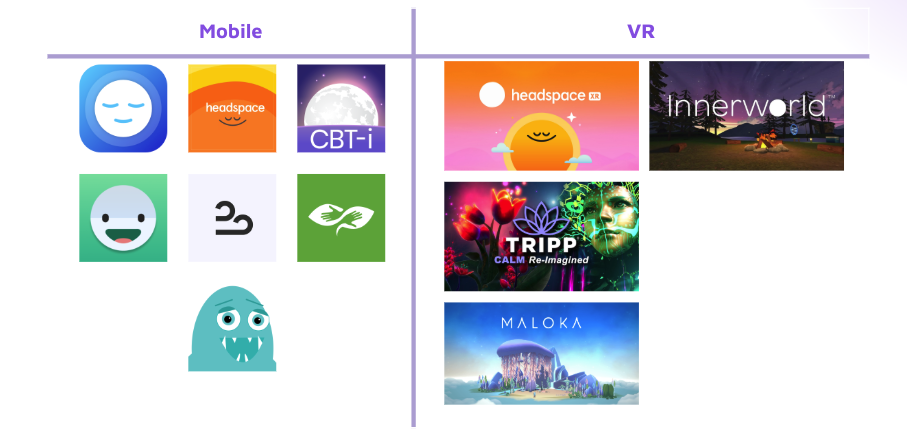
Mobile Apps Analysis: Included comprehensive usability and functionality reviews of apps like Rootd, which helps users manage anxiety through tools like breathing exercises and guided paths.
VR Apps Analysis: Focused on VR apps like TRIPP and Guided Meditation VR, assessing their immersive quality and user interaction models.
Comparative Feature Analysis

Breathing/Meditation Exercises
Both VR and mobile apps offer well-executed breathing exercises and meditation routines. VR adds an immersive layer that enhances user engagement.
And then it hit me..
Journaling 🌟
While mobile apps like Rootd and MindShift offer robust features including journaling, mood tracking, and daily check-ins, these are largely absent or underdeveloped in VR apps.
As my research progressed, it became clear that among the various calming and therapeutic methods available,
journaling—specifically writing—had not yet been fully explored or implemented within VR environments.
Recognizing the profound benefits of traditional journaling on mental health, such as promoting reflection and emotional clarity, my research honed in on the potential to adapt this practice for VR. This focus was driven by the goal to innovate how writing can be facilitated in immersive settings, thus expanding the tools available for mental wellness in VR and potentially enhancing the effectiveness of therapy through this underutilized approach.

Shifting Focus to Journaling in VR
Journaling for Mental Wellness
Journaling supports mental wellness by facilitating deep reflection.
It aids in emotional processing, helping users manage stress and anxiety.
Regular journaling is linked to improved mood and psychological well-being.
Journaling in VR
Research identifies a notable gap in VR mental wellness applications.VR frequently underutilized interactive features, particularly journaling.
None of the Mental wellness apps in VR include Journaling feature.
Preliminary User Surveys
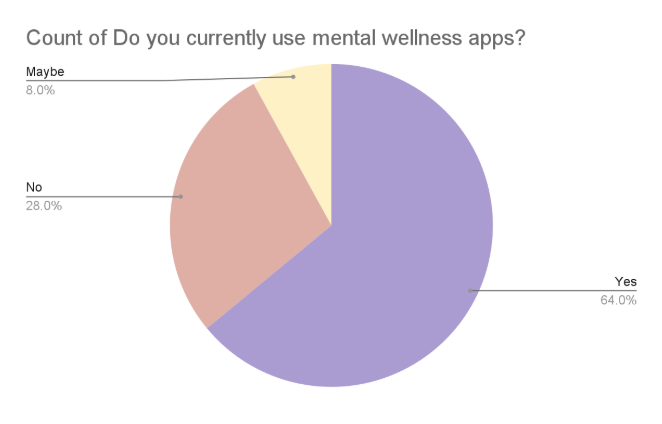
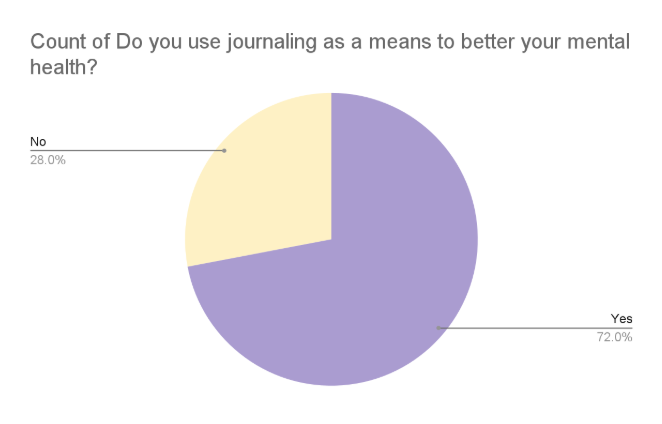



Prototyping and User Testing
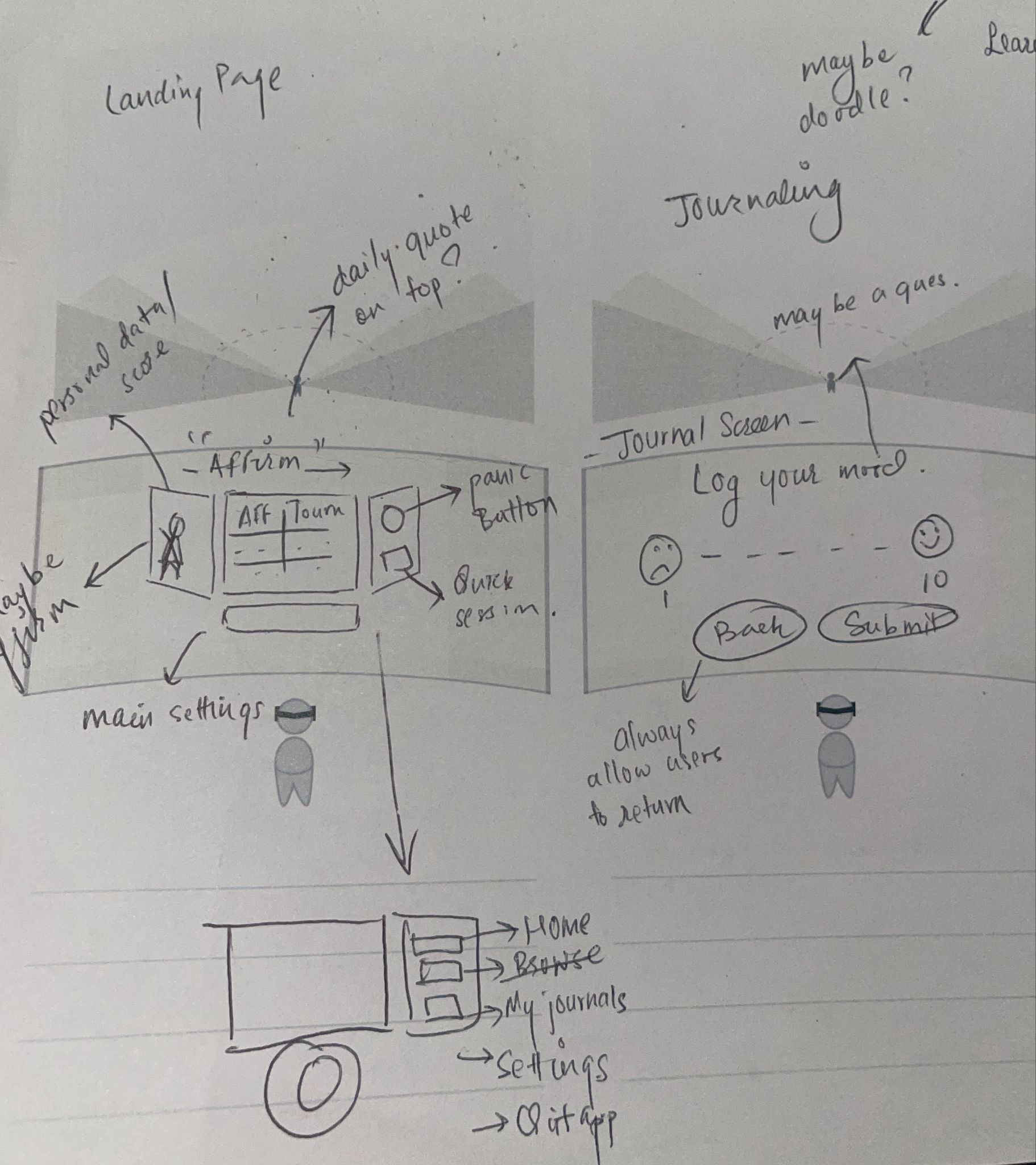
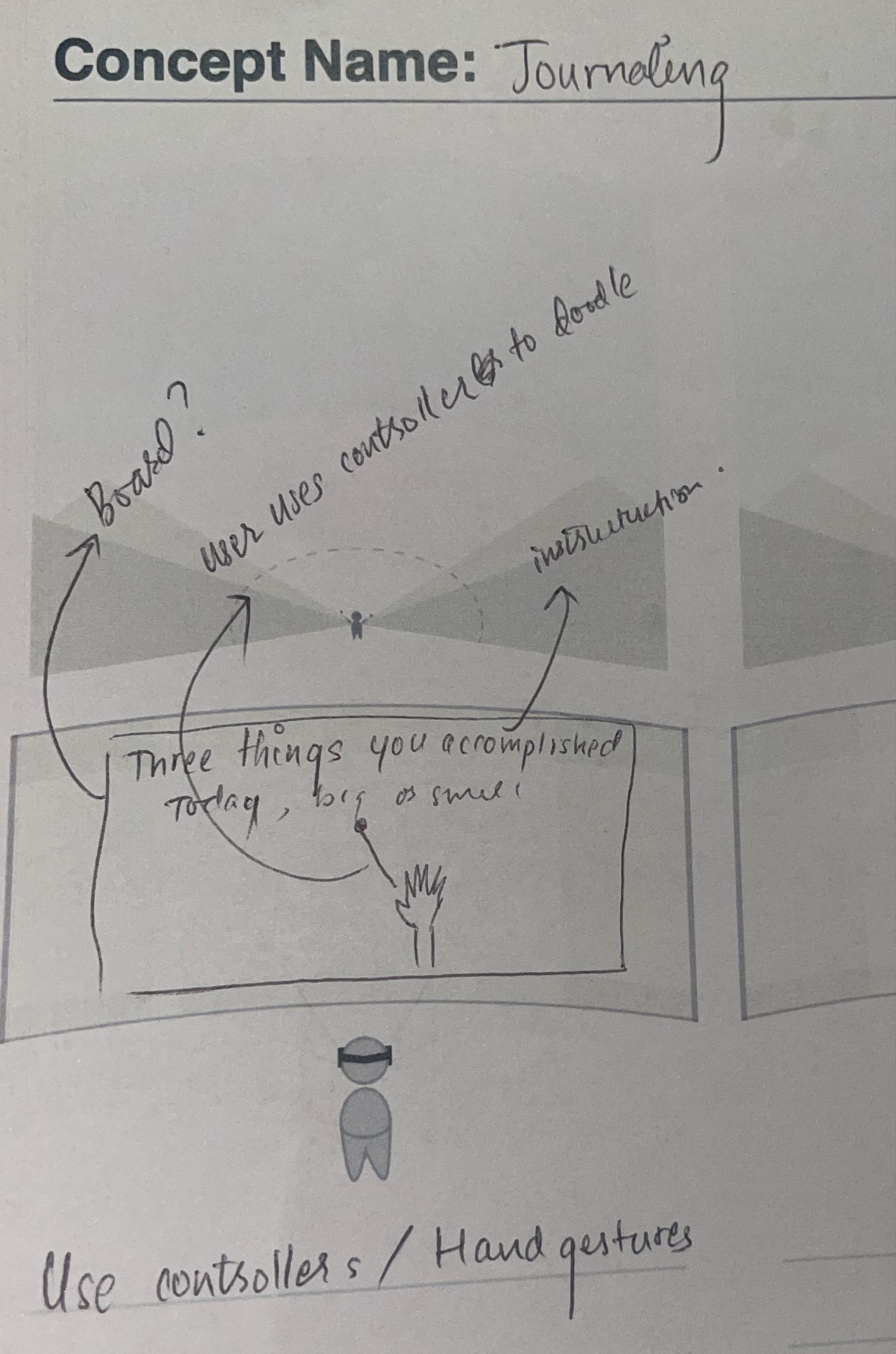
Based on user insights, I started sketching rough drafts of my prototype on paper, solely focusing on Journaling in VR.
My next step was to visualize in a virtual reality. I used ShapesXR on my Meta Quest 3 headset to create a simple prototype using 3D models imported from Sketch fab. I created some simple UI as shown in the video on Figma and used integrated it into ShapesXR.
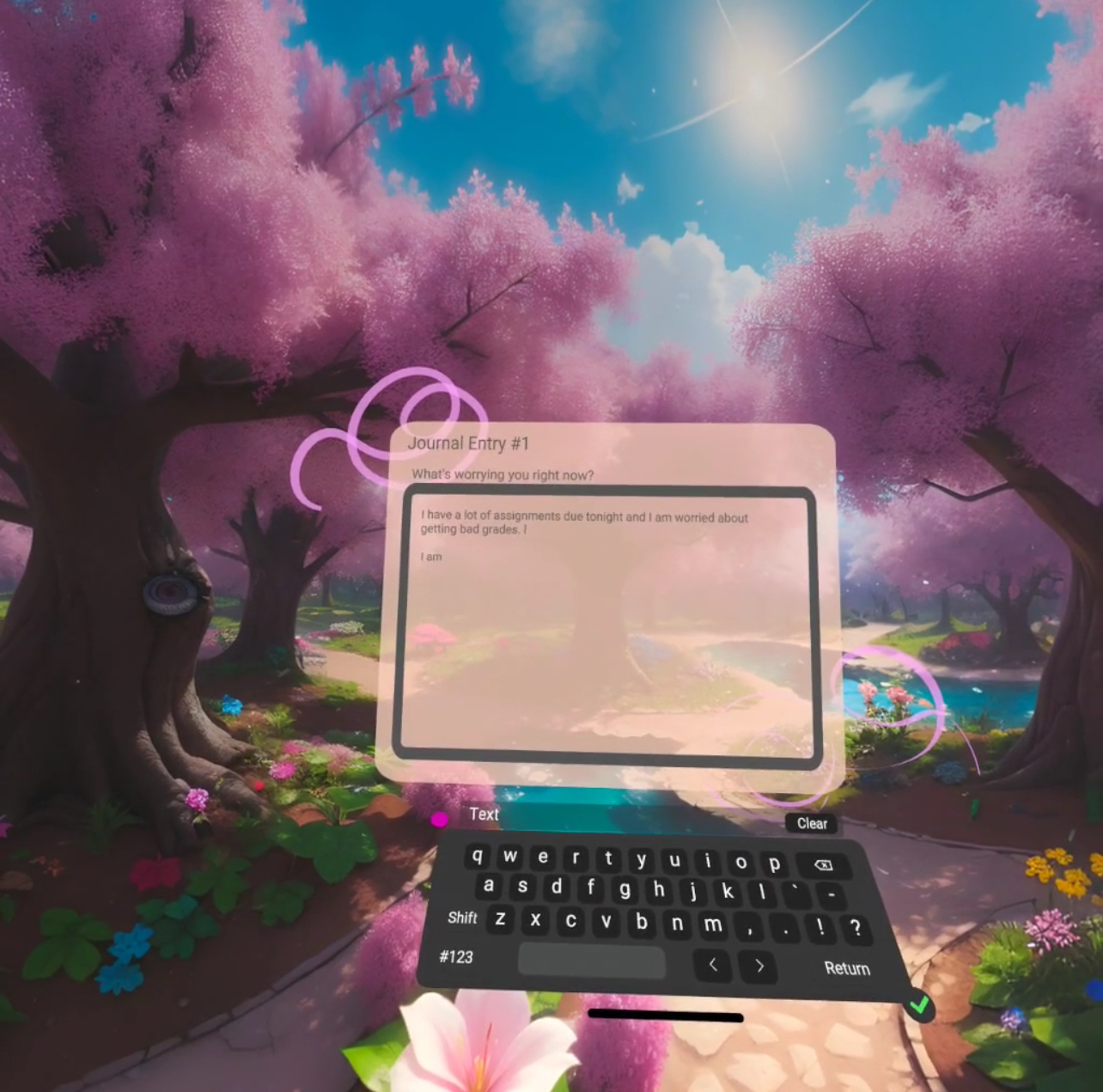
I developed several VR prototypes, including:
VR Journaling Application: Featured voice-to-text functionality and emotional recognition to facilitate a deeper level of user reflection and engagement.
Iterative Design Approach: Each prototype underwent multiple rounds of user testing, leading to continuous improvements based on direct feedback.
Usability Testing | Within Subjects Design
Evaluate physical and psychological comfort during VR use.
Assess the intuitiveness and user-friendliness of the interface.
Measure user engagement and the depth of immersion in the VR environment.
Identify and document any interaction problems or technical glitches.
Test how well the guided prompts facilitate reflective journaling.
Gather user opinions on environmental and audio features, and system responsiveness.
Compare experiences across VR, paper, and mobile to highlight VR's unique contributions.
Testing Schedule
Day 1: Participants make a journal entry on an empty piece of paper.
Day 2: Participants use the journaling feature in a VR prototype using given prompts .
Day 3: Participants journal using a mobile app (MindShift)

Usability Testing Outcomes
On the third and final day of testing, I asked my participants to fill out a quick survey and got the following results:


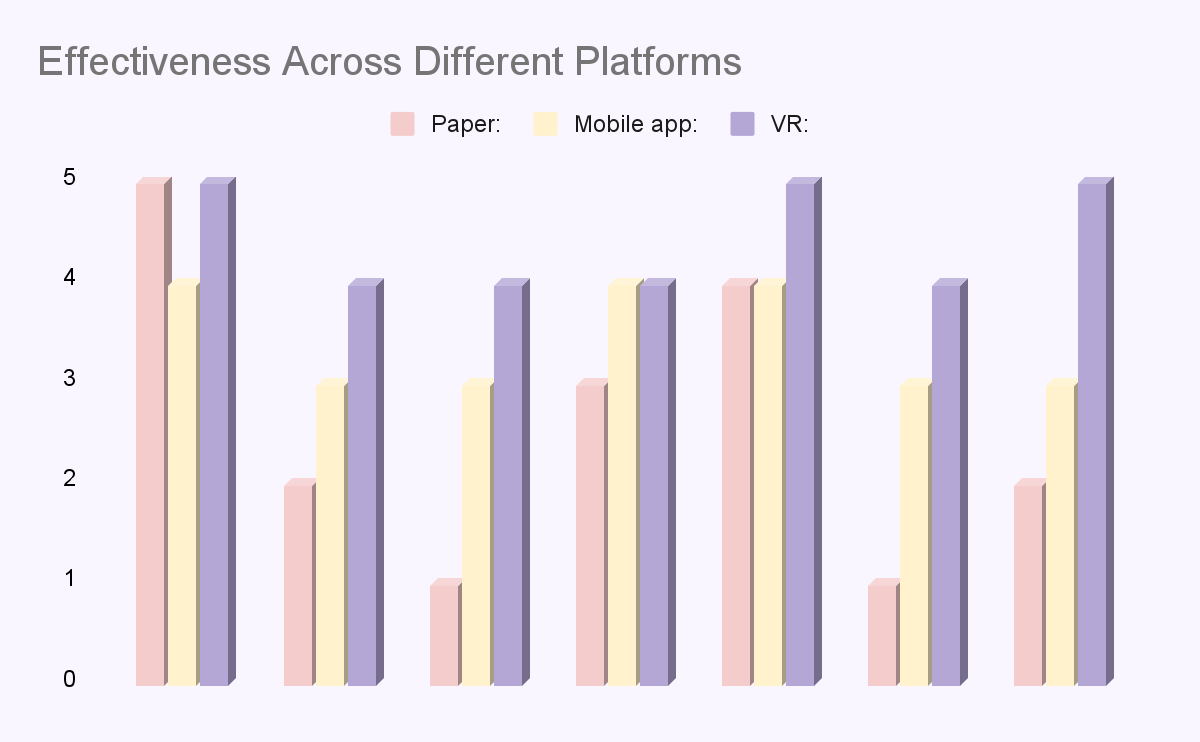
I then used the following metrics to analyze my research
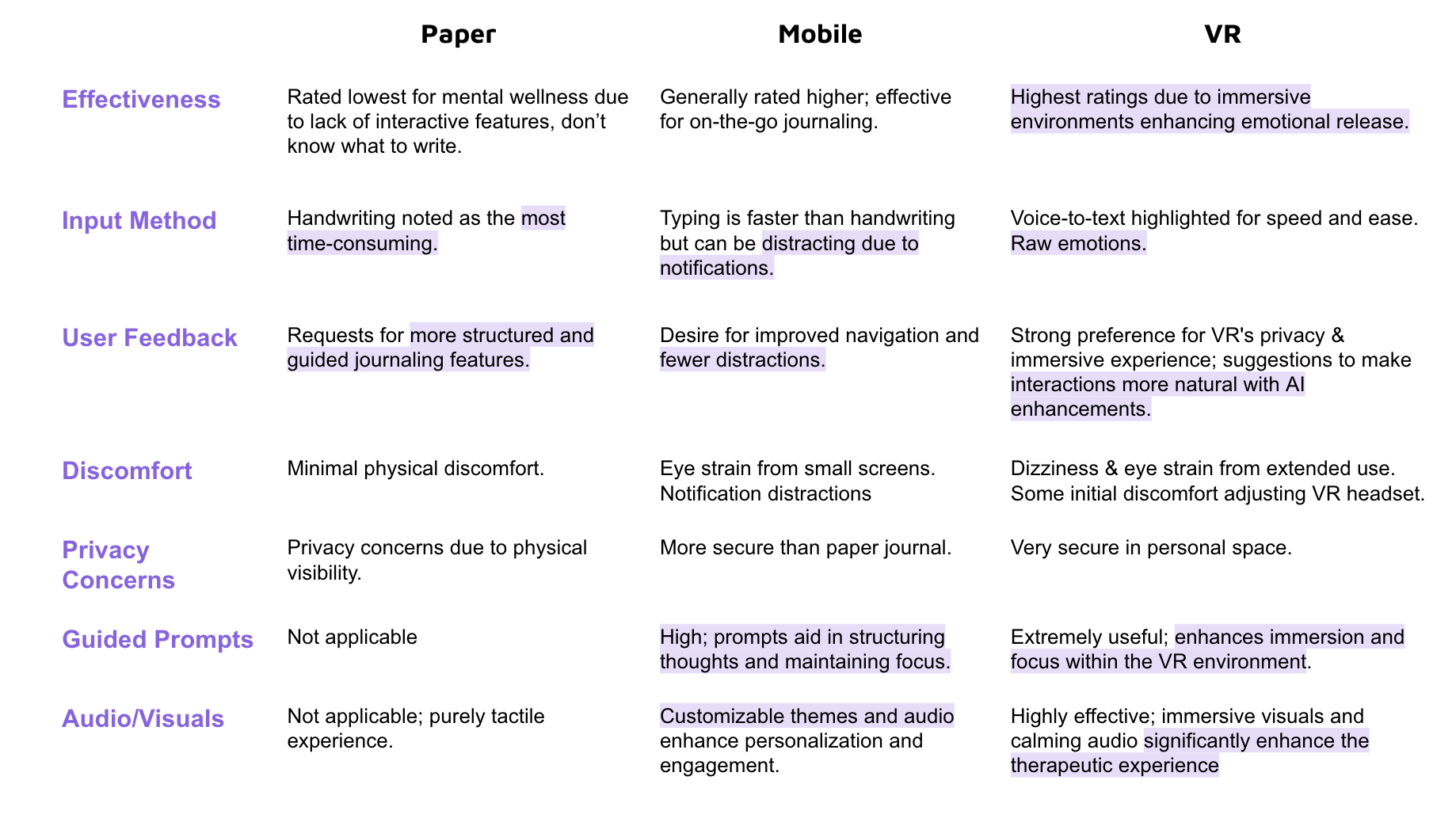
Key Findings
User Engagement: VR prototypes demonstrated significantly higher engagement levels, with users reporting greater emotional resonance and presence compared to mobile apps.
Usability Challenges: Identified specific usability hurdles in VR, such as navigation and user fatigue, which were addressed through iterative design improvements.
Therapeutic Potential: VR showed substantial promise in delivering more effective mental health interventions, particularly through personalized and immersive journaling experiences.

Conclusion and Implications
This research not only highlights VR's potential to revolutionize mental wellness interventions but also serves as a call to action for further development of VR applications in mental health. The findings advocate for a paradigm shift towards immersive therapeutic technologies that can offer profound mental health benefits.
Future Directions
Encourages continued exploration into VR’s capabilities, suggesting specific areas for future research such as the integration of AI for personalized therapy sessions and the expansion of VR's accessibility to a broader user base.

